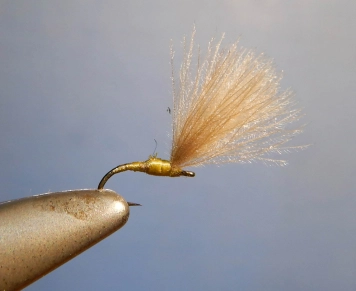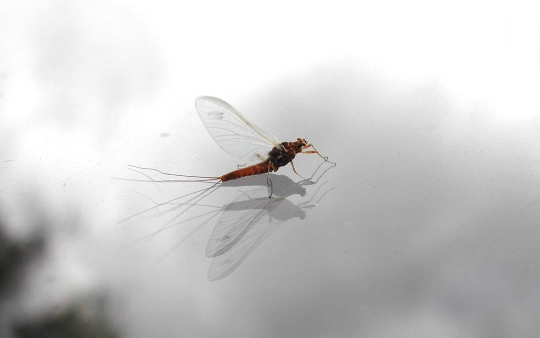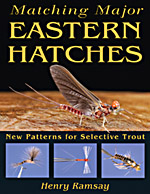In our continuous effort to obtain better and more practical mayfly imitations, we discovered a few new and simple solutions.
In a previous article we explained our approach for fishing Euro BWOs, the most important summer hatches, which include dozens of mayfly species.
Frank Sawyer wrote in Nymphs and the Trout that "In all branches of angling simplicity is an aim to be pursued, and simplicity can indeed be adopted in both dry-fly and nymph fishing", and Ernest Schwiebert wrote in Matching the Hatch that "Flies that take selectively feeding trout seem to be practical imitations".
Following their advice, in our continuous effort to obtain better and more practical fishing flies, we discovered a few new and simple solutions.
Nymphs
Frank Sawyer described nymphs as "the last stage during the underwater life of insects of the order Ephemeroptera which, except for the absence of wings and their longer tails, and legs, they have similarities with the insects which they will become when they burst from their nymphal skins and become airborne".
Although the term "matching the hatch" is usually used for surface flies, the hatch actually begins on the bottom several hours before the transformation on the surface takes place.
In Selective Trout and many other books about hatch matching, it was explained that prior to the hatch there is an increased nymph activity close to the bottom, and that trout use the chance to feed vigorously.
Although they are usually opportunistic feeders, trout can feed selectively on BWO nymphs, and occasionally we have observed such a behavior. Because of that, we must consider proper flies to match the nymphs ready to hatch. In those situations we prefer bead headed nymphs to others for the simple reason that, in our experience, the patterns become more effective with the bead.
The same impression is shown by Domenick Swentosky and is shared by other authors. However, they mostly think that beads convert the flies into attractors. We, on the other hand, believe that shiny beads turn nymphs into emergers. In our experience gold colored beads are working fine, and although there is a wide choice of colors on the market there is no need for anything else. The stories that fish can become "educated" to avoid gold beads are just one of many fly fishing anecdotes. We agree with Bob Wyatt that trout cannot be "educated" and that such tales are just excuses for the fisherman's errors.
A simple tool to investigate what trout are actually eating is a stomach pump. When used carefully it does not do any harm to the fish, and provides valuable information. In his videos Doug Swisher showed how it is properly done. We are showing two samples from the fish feeding during the first phase of the BWO hatch.
The nymph weight
The most important attribute of a nymph imitation is its weight. Whenever they can, trout and grayling are drift feeders, which means that they hold a position and wait for current to bring them food. When they feed that way they do not move very far to intercept the food, which is why we must present our nymphal imitations at the depth where the fish is holding.
This is often close to the river bottom, but not necessarily so – fish can be positioned at any depth. They chose their position based on the abundance of available food. In order to place our nymph at the right depth, it must have the appropriate weight. If the fish are feeding close to the surface, or in very shallow water, an unweighted nymph can be the right choice. The weight of the hook and plastic bead will be enough. But if the fish is deeper, the nymph must be weighted. Today we tie nymphs with various sizes of beads for this purpose. The beads are available in many colors, sizes and weights (plastic, brass or tungsten), and we have a big range of differently weighted nymphs. So with trial and error – and some experience – we can choose the correct nymph for any position in the river. The patterns we use are tied on curved (scud) hooks, because such flies are more closely shaped like wiggling BWO nymphs.
A true revolution in the concept of bead head nymphs came with Perdignon patterns from Spain. They started to use beads of various sizes, sometimes very large, which went outside of the previously accepted measure of nymph proportions. It became clear that fish actually do not care about the size of the bead, and we started to tie all physically possible combinations of hook and bead sizes. That became especially important for small BWO nymphs that have to sink very deep. Sawyer wrote that (in his time) it was not possible to make a Pheasant Tail Nymph to fish places deeper than 4 feet (1.2 m). We can only imagine how happy he would be today with tungsten bead headed PT nymphs.
The nymphs we use are very simple and don't look like much, but they have been thoroughly tested and they catch fish as well as the more "realistic" patterns. Fly tying "realism" is intended to catch humans, not fish. Even in slow moving rivers, a fish usually has much less than one second to decide if a drifting object is food or not, so simple flies can do a good job.
As you can see, we add "thread" in the names of all our flies to imply that their bodies are tied with nothing else but the tying thread.
Patterns
Emergers
Peter Hayes expressed a view that most artificial flies are taken because fish recognize them as emerging insects. This is very likely so, since even the "high floating" hackled patters sink a bit into the water surface and effectively become a sort of emerger or "drowned fly" imitations. However we believe that flies made as emergers on purpose are much more effective.
CDC is the finest available wing material for such flies because it has ability to float low on the water like real insets do. Also, CDC has small barbules which on the water surface achieve impression similar to mayfly wings. Wings of BWO duns (and all other Ephemeroptera) are covered with small hairs that help them repel water and stay dry. It seems that the main reason why CDC flies are so successful is those micro hairs.
Goran Grubić and Aleksandar Panić
The emergers we recommend are not much different from those in our previous text, but we discovered how to make them simpler and even more effective. They are tied just with the appropriately colored thread and tips of natural CDC feathers. In our experience it is better to use dark brown or khaki CDC rather than the "correct" dark blue dun, because brown is much more visible and fish don't seem to mind the difference. The wings are a bit longer than before because such flies are more visible and better floaters. Such emergers can be tied on almost any light wire hook, curved or straight, however we prefer the model given in the recipes.
Patterns
Duns
We still consider the flies we recommended in the previous text as the best. However, we changed and simplified the tying process for the No-hackle Dun pattern by omitting dubbing for the thorax. Such flies have a more elegant and slimmer profile, and we have written about them before. Actually, by doing this we came closer to the legendary F-Fly invented by Marjan Fratnik, which was the first pattern to use CDC for wings.
The body color of our BWO Dun is rather light compared to what is usually recommended for BWOs. A simple search on the Internet for BWO pictures will reveal that the flies come in many color mixtures of yellow, olive and brown. For example, there are beautiful BWO photos on Michael Flenet's website, Kjell Rakkenes' website, European Fly Angler and many other websites. All insects are very pale after hatching and then become darker and darker with time. Fish actually have chance to feed on them only during the process of hatching and a few minutes after that (aside from the spinner fall, which happens much later).
A minute or two after hatching, the BWO's body is light golden yellow olive, as can be seen in this picture. Newly hatched flies can be recognized by rather short tails (cerci), which become longer in a few minutes.
The second picture shows a little duller color in the specimen some 15 minutes after hatching.
The third picture shows a BWO 5 hours after the hatch (trapped in a fly box).
These observations helped us to decide to use only light olive bodies in BWO Dun flies.
Patterns
Spinners
The BWO spinner fall may happen at any time of the day, but most often it appears in the evening (G.E.M. Skues). Timing can be different on various rivers, and on some rivers where we fish, it usually happens so late in the night that we almost never have chance to fish the spinners. This is a pity because a spinner fall can be a fine chance for good fishing.
The parachute pattern we have shown in the previous article is very useful, but sometimes it is better to use CDC pattern for picky trout.
Also, sometimes it is very effective to fish a wet spinner, especially late in the evening when visibility is low. That way we extend our fishing into a period where it is impossible to see the dry fly – and when fish may still be very active.
BWO spinners are often called Sherry Spinners because of their body color, and this is certainly accurate for Serratella ignita. But there are 11 other Euro BWO species, and the color of their bodies may be different. Some are dark brown, some tan or almost beige. Therefore it can be helpful to do a little observation and look for the predominant color.
Patterns
Fishing suggestions
On some freestone rivers matching the BWO hatch can be simple. But on many other rivers, especially spring fed streams and tailwaters, it can be quite demanding. Even the best fly will not catch fish if it's not fished correctly, so we must emphasize some practical recommendations for selective trout fishing in BWO hatches that we gave earlier.
Try to avoid drag at all costs using whichever casting and mending technique is needed.
Use as long leader as necessary (5 meters or 15' is not too long) with a fine tippet (0.08-0.12 mm).
Use a medium fast or slow rod to protect the fine tippet.
Use a dry fly one size smaller than the naturals you see on the water (they appear larger in the air especially in the sun).
If the fish refuse a fly after several correct presentations then change to one size smaller fly.
When fish are actively feeding don't waste time on drying your CDC fly. Let it dry on a fly patch, and exchange it with a dry one. Fish prefer "fresh" CDC flies to the dried ones, and it is much quicker to replace a fly than to desiccate it properly – and a good hatch does not last forever. Therefore, fill your box with ample amounts of flies of each pattern and size.
During a heavy BWO hatch, when fish are boiling everywhere around us and we are not catching them, it is natural to conclude that we are not using the proper fly. In our experience most often the problem is in the presentation and not in the fly. There is a ridiculously simple test for that. We cut the fly from the tippet (debarb it if the hook is not barbless), and place it on the water to go with the drift in the feeding lane. If a fish take it, it will spit it very quickly, and we know that the problem is with the presentation not with the fly. And viceversa, of course.
Of course we throw away one fly for doing this test, but that can be small price for the answer we are getting.
Hand picked for this article
- Log in to post comments






























